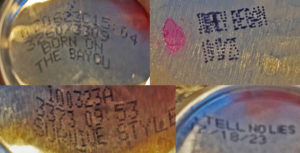Craft beer is typically created by a brewer from all natural ingredients, is not pasteurized, and has no additives to prevent changes in beer due to aging. This is distinctly different than the “Big Beer macro-lagers” that are almost always pasteurized (boiled) before packaging – primarily to create a longer “shelf life” and consistency to what’s left of the flavor. Unlike craft, some even add preservative additions to the beer.
Different characteristics of the type of beer itself have an impact on aging, the higher the ABV (Alcohol by Volume) in the brew and usually the darker the beer, the less it degrades over time. Many high ABV beers actually age quite well, and can be “put down” for years. Conversely, the lighter the body and flavor, the more quickly the intended taste changes over time. Hoppy, lighter bodied beers lose their hop flavor and aroma relatively quickly, so according to brewers should be consumed within three to four months of packaging.
The type of beer packaging itself also has a major influence on how well beer ages, as light and oxygen age beer prematurely. Canned beer is almost always a better alternative to bottles for this reason.
Why do we care about a beer’s age?
The primary reason to be sure your beer is fresh when you buy it is that old beer does not taste as good as fresh beer – and usually does not taste like what the brewer intended it to. And depending how old the beer is, it can actually spoil – and all kinds of unexpected results can occur. These include flat beer, nasty tastes (“cardboard” or “vinegar”) and sometimes even cascading explosions of foam when opened.
The good news is that except in extremely unusual situations, old and even spoiled beer won’t make you sick. It just won’t taste good. In fact, in the 1700’s it was routine for public houses to mix old beer with new beer to extend it’s drinkable age, and save the cost of tossing out the old stuff.
in 2024 ensuring that your craft beer is fresh is even more important. Finding yourself with an off tasting four pack is even worse now because the cost has gotten so significant. When you blow $18 on a four pack, it really matters if you have to toss it. And, as this year begins, the popularity of craft beer is starting to slip, so the plethora of different beer brands are just not turning over as fast. Beer stores are finding themselves with a lot of inventory – and they don’t always know how old it is, or how it has been handled since it left the brewery. Has it been sitting in a hot warehouse for months before delivery to them?
 Bottom line is that if you love craft beer, and in particular if hoppy styles are your thing, beer age is your enemy.
Bottom line is that if you love craft beer, and in particular if hoppy styles are your thing, beer age is your enemy.
How long does craft beer stay fresh?
According to an article published by Upstream Brewing in 2021, in general “you can expect a craft brew to last for six to nine months in the pantry and six months to two years in the refrigerator.“ An article in Brewer World titled “Everything You Need To Know About Expired Beer” states that “As a general rule of thumb, sealed beer is shelf-stable for 6 to 8 months without refrigeration. If stored and refrigerated properly, sealed beer can last beyond its expiration date up to 12 months.” So, there is no specific answer, but you get the idea.
Again the style of beer matters: Sierra Nevada says in an article on their website “Our lagered beers – like Pivo, Cerveza, or 805 and any of our stouts – have a six-month shelf life. Other beers like Mind Haze, Hopnosis have a four-month shelf life.” Upstream Brewery also points out that for different types of beer age matters: “Lighter beers, such as IPAs and pale ales, are best consumed within 120 days after brewing”.
As Brewer World explains: “No matter what extra steps brewers take to prevent beer from spoiling, there is nothing they can do to stop the natural growth of bacteria and chemical reactions as time passes.”
So, How can you protect myself from old off tasing craft beer?
Most breweries are now putting a “brewed on date” on the bottom of their beer cans – inked with dates and sometimes other information. Unfortunately, different breweries use different labeling methods, and some even use a different dating system than you or I are used to. Some don’t date all the cans in the package, others none at all – as it is not required by law.
While this may sound obvious, checking the date when you are home, after you have already bought the beer, is not the best time to look for it (in particularly if you’ve already opened the can!). So check it in the store before you buy if at all possible – or buyer beware.
If you are buying hoppy beers with alcohol lower than 6% any beer more than 4 months past the brewing date is just not going to taste the same. Just about any craft beer older than one year from brewing date is going to suffer. Better to stay away! (The only exceptions are the high alcohol and darker beers, as previously explained.)
What do you do if you find you have old craft beer?
Most respectable beer distributers and beer bottle shops will take back the old out of date beer. You just bring them the remaining offenders and they should swap them out or refund the four pack cost. If you are buying directly from a brewery or tap room they absolutely want to know about age issues, and will usually be appreciative that you brought it to their attention. A brewer friend of mine told me that I should let the brewery itself know if their old beer is out there – even at a bottle shop, as it can potentially ruin the brewery’s reputation.
So, as craft beer becomes more expensive and somewhat less popular, craft beer appreciators should keep their eye out for their beer’s age. My advice to you is that if you aren’t sure, just walk away from the beer, and find one that’s fresh. Out with the old (craft) in with the new in 2024!






